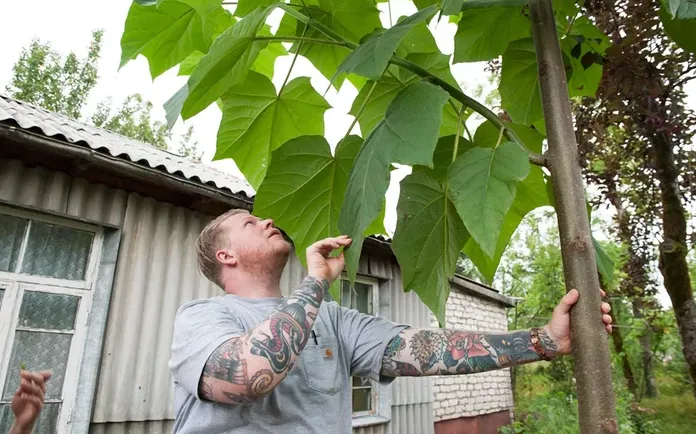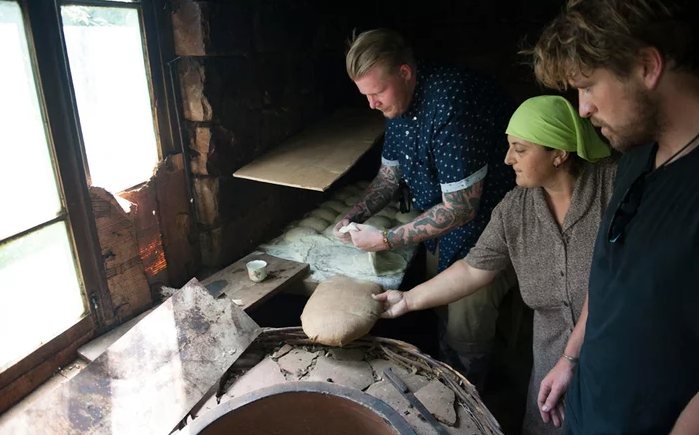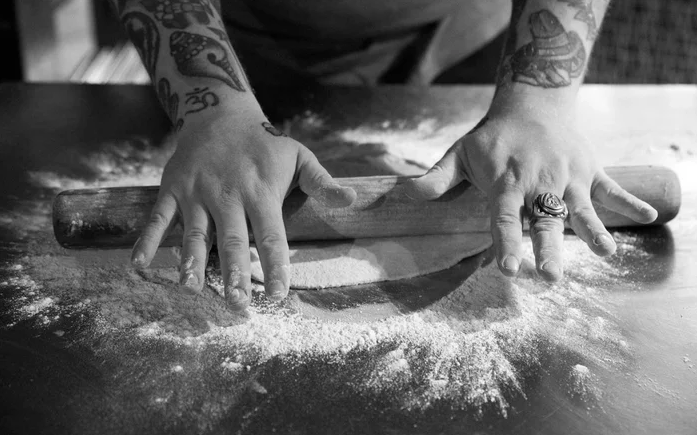Forget Baguettes — Why In-the-Know Bread Lovers Should be Heading to the Caucasus (Recipe)
During a culinary research trip to the Republic of Georgia, a team of chefs tour backyard bakeries — and return with inspiration for their flatbread
/https://tf-cmsv2-smithsonianmag-media.s3.amazonaws.com/filer/28/63/28637dfe-0133-4e99-b3d5-ed143dd7eeaa/image.jpeg)
“Chris burned all his arm hairs off.”
Rose Previte laughs, recalling a memorable day of bread baking in Georgia’s Racha highlands. The part owner of Maydan (entrées $12–$48) — a new D.C. restaurant tracing a common culinary ancestry across North Africa, the Middle East, and the Caucasus — visited Georgia last year as one leg of a multi-country preopening trip with co-owners and executive chefs Chris Morgan and Gerald Addison.

The chewy, bubbly flatbread the chefs learned to make in Georgia is now at the literal center of Maydan’s operation, made fresh throughout dinner service in the Georgian-style tonés (massive, cylindrical clay ovens) blazing in the middle of the dining room.
Previte had first encountered Georgian bread while living in Moscow with her husband, NPR host and then-foreign correspondent David Greene, remembering, “the best thing that came out of that was learning about Georgian food.” She had already turned D.C. on to the country’s natural wines and cheesy, bready khachapuri at her first restaurant, international street-food spot Compass Rose (small plates $8–$20). Now, she was excited to place the cuisine in a broader, more global context.

The group decided to drive from Tbilisi to the beach town of Batumi, exploring the distinct food culture of Georgia’s western region. Driving westward to the Black Sea, they would stop and study under the women baking along the road — learning to make the ubiquitous shotis puri (long, doughy spears) and regional specialties like nazuki, sweetened with cinnamon and raisins.
But the breakthrough came late in the trip: behind a tiny winery in the Rioni River valley, a woman in a small hut taught them how to make a thinner lavashi style of bread that looked a little like something they’d seen in Lebanon, a little like the flatbreads at their favorite Syrian falafel shop in Istanbul.

For Addison, the woman’s bread — which inspired Maydan’s recipe — was a missing link: utterly Georgian, but somehow a distillation of all the lessons and flavors they’d picked up during their travels.
Morgan remembers it a little differently: “Gerald and I looked at each other like, Damn, this is the bread we’ve been looking for.”

How to make Maydan's Toné Flatbread
Active time: 50 minutes
Total time: 2 hours, 40 minutes
Makes 18 flatbreads
Ingredients
1 Tbsp. active dry yeast 1½ Tbsp. honey
3 cups warm water (110°F)
1½ Tbsp. canola oil, plus more for greasing
6 cups bread flour, plus more for rolling
2½ cups whole-wheat flour
2½ Tbsp. kosher salt
Step 1
Combine yeast, honey, and warm water in the bowl of a heavy-duty stand mixer fitted with the dough hook attachment; let stand until foamy, 4 to 6 minutes. Stir in oil.
Step 2
Combine flours and salt in a separate large bowl. Run mixer on low speed and gradually add flour mixture to yeast mixture, until all flour is incorporated, 10 to 12 minutes. Increase speed to medium-low and mix until dough forms a ball and begins to pull away from sides of bowl, 6 to 8 minutes. Turn dough out onto a lightly floured work surface. Knead a few times, about 30 seconds. Form dough into a ball. Lightly grease a large bowl with oil and transfer dough to bowl, turning to coat; cover with plastic wrap and let stand in a warm place until doubled in size, about 1 hour.
Step 3
Place a pizza stone on bottom rack of oven; preheat oven to 500°F. (Leave pizza stone in oven while oven preheats.) Place dough on work surface lightly dusted with flour. Punch down dough and cut it in half. Cut each half into nine pieces and roll each piece into a ball. Cover with towel and let stand 10 minutes. Roll out dough balls into 6-inch rounds. Arrange rounds on a floured work surface or on floured baking sheets; cover loosely with plastic wrap. Let rise until puffy, about 25 minutes.
Step 4
Using a lightly floured pizza peel, slide three rounds at a time onto hot pizza stone and bake until rounds have puffed up and bottoms are lightly browned, 4 to 5 minutes. Serve hot, or wrap in aluminum foil to keep warm.
Other articles from Travel + Leisure: